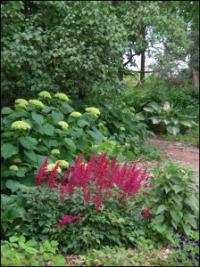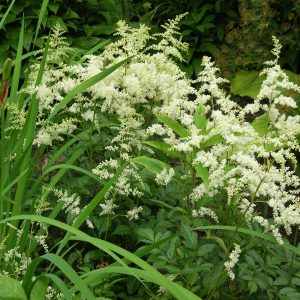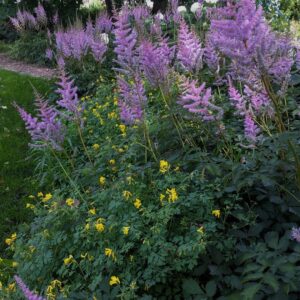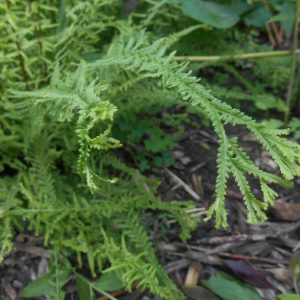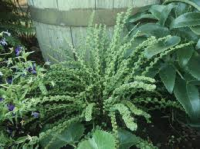Shop
Showing 105–112 of 778 results
-
Astilbe andresii ‘Fanal’ Z 4-8
Marlboro red plumes in June
OUT OF STOCK
Striking Marlboro red plumes in June
Size: 24"x 18"
Care: sun to part shade, moist soil. Immune walnut toxicity
Wildlife Value: attracts butterflies
Awards: Royal Horticultural Society Award of Garden MeritAstilbe is Greek from a meaning “without” and stilbe meaning “lustre” referring to the fact that the leaves are not shiny. Cross of A. japonica and A. davidii made by Arends, nurseryman from Ronsdorf, Gemany (1862-1952), in 1930.
-
Astilbe andresii ‘Brautschleier’ Bridal Veil Z 4-8
White plumes turning creamy in July
White plumes turning creamy in July
Size: 30” x 30”
Care: sun to part shade, moist soil essentialAstilbe is Greek from a meaning “without” and stilbe meaning “lustre” referring to the fact that the leaves are not shiny. Hybrid by George Arends, nurseryman from Ronsdorf, Germany in 1929.
-
Astilbe chinensis luo xin fu in China Z 4-9
Pink plumes in mid-summer atop fern-like foliage. More tolerant of sun and well-drained soil than the hybrids.
Pink plumes in mid-summer atop fern-like foliage. More tolerant of sun and well-drained soil than the hybrids.
Size: 24” x 24” spreads
Care: Sun to shade in moist or moist well-drained soil
Native: Siberia, China, KoreaAstilbe from “the Greek word for without” and stilbe meaning “lustre” referring to the fact that the leaves are not shiny. 1st described for the West by botanist Carl Johann Maximowicz in 1859 and then named Hoteia chinensis. Liberty Hyde Bailey termed this plant “graceful” in the early 1900’s.
-
Astrantia major Masterwort Z 4-7
Blush-pink leaf-like bracts with pointed ends surround crowds of tiny, cramped flowers, pincushion-like stand tall above low foliage blooming from June-August.
Blush-pink leaf-like bracts with pointed ends surround crowds of tiny, cramped flowers, pincushion-like stand tall above low foliage blooming from June-August.
Size: 12-36” x 12”
Care: Sun to part shade in moist to moist well-drained soil
Native: Europe
Awards: Elisabeth Carey Miller Botanical Garden Great Plant PicksAstrantia is Greek meaning “star” referring to the star-like appearance of the flowers. European gardens by 1596 and in early colonial gardens in Plymouth, Massachusetts Bay Colony in the 1630’s. The root was used as a purgative.
-
Athyrium filix femina ‘Victoriae’ Victoria lady fern Z 4-8
Clumping fern with finely divided fronds have tiny, twisted leaflets that cross one another. Vigorous grower. Dr, John Mickel, former curator of ferns at the New York Botanical Garden, called this “the Queen of green.”
OUT OF STOCK
Clumping fern with finely divided fronds have tiny, twisted leaflets that cross one another. Vigorous grower. Dr, John Mickel, former curator of ferns at the New York Botanical Garden, called this “the Queen of green.”
Size: 18-24” x 18-24”
Care: part to full shade in moist to moist well-drained soilPopular Victorian fern. Mutation of Lady Fern discovered in Scotland in 1861.
-
Athyrium filix-femina Lady fern Z 3-8
Clumping fern with lance-shaped, double compound fronds – leaflets upon the midrib usually opposite one another, 1-2’ long and 5-12” wide and tapered to a point at the tip. One of the easiest ferns to grow.
Clumping fern with lance-shaped, double compound fronds – leaflets upon the midrib usually opposite one another, 1-2’ long and 5-12” wide and tapered to a point at the tip. One of the easiest ferns to grow.
Size: 4’ x 2-4’
Care: moist to well-drained soil in full to part shade
Native: temperate No. America including Wisconsin
Awards: England’s Royal Horticultural Society Award of Merit.Chippewa made a decoction of the root for it diuretic. Meskwaki made a decoction from the roots to relieve breast pain after childbirth. For Ojibwa and Potawatomi it brought on milk flow in nursing mothers with caked breast. Ojibwa also dried and grated roots to heal sores. Quileute wiped fish with the leaves and ate roasted, peeled root.
First described for botany, but given a different name, by English botanist Leonard Plukenet (1641-1706) in 1692. -
Athyrium filix-femina ‘Frizelliae’ Tatting fern Z 4-8
Clumping fern bearing unusual fronds – button-like along the midrib
OUT OF STOCK
Clumping fern bearing unusual fronds – button-like along the midrib
Size: 18” x 18”
Care: Moist humusy soil in part sun to part shade
Awards: Great Plant Pick Award from Elizabeth Carey Miller Botanical Garden.Short genetic mutation of Lady Fern discovered in 1857 in Mrs. Frizelle’s garden in Ireland.
-
Aurinia saxitilis syn. Alyssum saxatile Basket of Gold Z 4-7
Taxi cab yellow rounded, dense mass of flowers envelops the plant from May to June
Taxi cab yellow rounded, dense mass of flowers envelops the plant from May to June
Size: 10" x 12"
Care: Full sun well-drained soil, cut back after flowering to maintain compact form. Drought tolerant
Native: Central and southeastern Europe
Awards: England's Royal Horticultural Society Award of Garden MeritAncient Greeks may have used this to cure hydrophobia. English garden cultivation since 1710. Grown by Washington at Mount Vernon.

